|
Selasa, 16 September 2008 |
| Gajah Mada
|
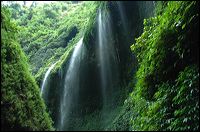 According to the Nagarakertagama, and supported by inscriptions dating from the late 13th and early 14th centuries, Raden Wijaya Sri Kertarajasa Jayawardhana married the four daughters of Kertanagara. From his eldest and principal queen, Dyah Dewi Tribhuwaneshwari, was born a son, Jayanagara, who succeeded to the throne on his father's death in 1309. According to the Nagarakertagama, and supported by inscriptions dating from the late 13th and early 14th centuries, Raden Wijaya Sri Kertarajasa Jayawardhana married the four daughters of Kertanagara. From his eldest and principal queen, Dyah Dewi Tribhuwaneshwari, was born a son, Jayanagara, who succeeded to the throne on his father's death in 1309.
During the reigns of both Kertarajasa and Jayanagara the focus was on the establishment of stability within the new state. Numerous uprisings occurred, all of which were put down successfully, though not without cost of lives. Then, in 1328, Jayanagara was assassinated. It is said that he was overprotective towards his two half sisters, born from Kertarajasa's youngest queen, Dyah Dewi Gayatri. Complaints lodged by the two young princesses led to the intervention of Gajah Mada, the talented minister who was later to take Majapahit to the height of its glory. He arranged for a surgeon to murder the king while pretending to perform an operation
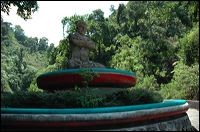 With the death of Jayanagara the throne of Majapahit was without a direct male heir. The position was occupied instead by the eldest of the deceased king's two sisters, Tribhuwana Wijayatungga Dewi, who ruled until 1350. By that time her son, Hayam Wuruk, who had been born in 1334, became old enough to take over. During his reign, as well as that of his mother, effective power was in the hands of Gajah Mada, who had been appointed prime minister and commander-in chief. With the death of Jayanagara the throne of Majapahit was without a direct male heir. The position was occupied instead by the eldest of the deceased king's two sisters, Tribhuwana Wijayatungga Dewi, who ruled until 1350. By that time her son, Hayam Wuruk, who had been born in 1334, became old enough to take over. During his reign, as well as that of his mother, effective power was in the hands of Gajah Mada, who had been appointed prime minister and commander-in chief.
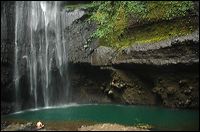 Gajah Mada stands among the greatest of Indonesia's heroes. From the time when he swore his famous oath of allegiance, the Sumpah Palapa, until his death in 1364, a period of just 28 years, he succeeded in spreading the power and influence of Majapahit throughout the archipelago, and even beyond the boundaries of the present day Republic of Indonesia. Gajah Mada stands among the greatest of Indonesia's heroes. From the time when he swore his famous oath of allegiance, the Sumpah Palapa, until his death in 1364, a period of just 28 years, he succeeded in spreading the power and influence of Majapahit throughout the archipelago, and even beyond the boundaries of the present day Republic of Indonesia.
  |
|
|
|
|
| Raden Wijaya
|
 In February 1292 the Mongol emperor of China, Kublai Khan, ordered the preparation of a punitive naval expedition directed against Java. It was partly an act of retaliation for King Kertanagara's refusal to pay tribute to China, and especially for the cruel and contemptuous way in which the Javanese ruler had disfigured the face of an imperial envoy. In February 1292 the Mongol emperor of China, Kublai Khan, ordered the preparation of a punitive naval expedition directed against Java. It was partly an act of retaliation for King Kertanagara's refusal to pay tribute to China, and especially for the cruel and contemptuous way in which the Javanese ruler had disfigured the face of an imperial envoy.
The fleet, which is reported to have consisted of 1000 ships, manned with 20,000 soldiers, was ready to leave by November. The journey was hazardous and beset with ill- fortune. Almost immediately after departure the convoy was hit by a typhoon; it was refused entry into Champa, where the loading of fresh supplies had been anticipated, and consequently by the time it approached the harbour at Tuban on Java's north coast the force was already demoralized, many of the soldiers suffering from starvation and dysentery.
The Chinese army was greeted by representatives from the new settlement at Majapahit, who explained that Kertanagara had been defeated and killed a few months previously and that his throne had been seized by a usurper, Jayakatwang of Kediri. The rightful heir, Raden Wijaya, son-in-law of Kertanagara, had established a stronghold at Majapahit and was asking for assistance in the annihilation of their common enemy, in return for official tribute.
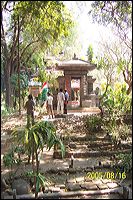 An alliance was formed and on 15 March 1293 the combined force launched an attack on Daha (Kediri). The final assault on the capital was made five days later, resulting in the loss of 5000 Kediri lives and the surrender of Jayakatwang. Raden Wijaya then returned to Majapahit, ostensibly to prepare his tribute settlement, leaving his allies to celebrate their victory. Quickly mobilizing his forces again, however, he turned on the Chinese army in a surprise attack, killing many and sending the rest running back to their ships. In this way Raden Wijaya established the kingdom of Majapahit. Seven months later, in November 1293, he was officially enthroned, bearing the royal title Kertarajasa Jayawardhana. An alliance was formed and on 15 March 1293 the combined force launched an attack on Daha (Kediri). The final assault on the capital was made five days later, resulting in the loss of 5000 Kediri lives and the surrender of Jayakatwang. Raden Wijaya then returned to Majapahit, ostensibly to prepare his tribute settlement, leaving his allies to celebrate their victory. Quickly mobilizing his forces again, however, he turned on the Chinese army in a surprise attack, killing many and sending the rest running back to their ships. In this way Raden Wijaya established the kingdom of Majapahit. Seven months later, in November 1293, he was officially enthroned, bearing the royal title Kertarajasa Jayawardhana.
  |
|
|
|
|
| Kertanagara
|
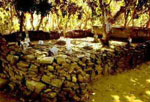 The last and most well known of the Singosari kings was Kertanagara. Praised in the Nagarakertagama as a devout Buddhist, well versed in many branches of philosophy and esoteric science, he is considered to have been the first Javanese ruler to envision a united Indonesia. Kertanagara's dreams, however, were not to be fully realized until half a century after his death, during the reign of King Hayam Wuruk of Majapahit. The expansionist foreign policy which he pursued, partly as a response to the increasing threat posed by the Mongol emperor, Kublai Khan, was perhaps too ambitious. His expedition to Bali in 1284 was inconclusive, while the army which he sent to subjugate the kingdom of Malayu in lower Sumatra left him unable to cope with rebellion closer to home. Kertanagara had, further, lost the favour of a number of powerful and influential statesmen, who had been loyal to his father, Wishnuwardhana. Two of these especially, the former prime minister Mpu Raganata and the security advisor Aria Wiraraja, had been relegated to lower positions in the new government. The last and most well known of the Singosari kings was Kertanagara. Praised in the Nagarakertagama as a devout Buddhist, well versed in many branches of philosophy and esoteric science, he is considered to have been the first Javanese ruler to envision a united Indonesia. Kertanagara's dreams, however, were not to be fully realized until half a century after his death, during the reign of King Hayam Wuruk of Majapahit. The expansionist foreign policy which he pursued, partly as a response to the increasing threat posed by the Mongol emperor, Kublai Khan, was perhaps too ambitious. His expedition to Bali in 1284 was inconclusive, while the army which he sent to subjugate the kingdom of Malayu in lower Sumatra left him unable to cope with rebellion closer to home. Kertanagara had, further, lost the favour of a number of powerful and influential statesmen, who had been loyal to his father, Wishnuwardhana. Two of these especially, the former prime minister Mpu Raganata and the security advisor Aria Wiraraja, had been relegated to lower positions in the new government.
According to one historical account, the Kidung Panji Wijayakrama, the rebellion which led to Kertanagara's death in 1292 was, in part, incited by Wiraraja, who had been given a relatively minor position as governor of Sumenep in Madura.
From information contained in the inscription of Mula Malurung, we learn that Kertanagara, as crown prince and heir apparent to the throne of Singosari, had already been installed as ruler of Kediri in 1254, fourteen years before his father's death. This event was unlikely to have pleased his brother-in-law, Jayakatwang, who claimed direct descent from the old kings of Kediri, and who was thus looking for an opportunity for revenge. The moment came in 1292. Despite repeated warnings from his ministers, Kertanagara did not recognize the weakness of his position. The result was that he died defending his palace, together with many of his closest followers, heavily outnumbered by the forces of Jayakatwang. The story of the gallant but hopeless defense put up by his son-in-law, Raden Wijaya, has been preserved in detail in the famous Kudadu inscription, discovered on the slopes of Mt Butak, to the south of Mojokerto. The inscription relates how the two commanders, Raden Wijaya and Ardaraja, had been given the task of defending the area north of the Singosari capital. Ardaraja, however, who was a son of Jayakatwang, is said to have betrayed his comrade and, perhaps on account of divided loyalty, gone over to the enemy. Reduced finally to an exhausted force of just twelve men, Raden Wijaya fled across the Strait of Madura and took refuge with Aria Wiraraja in Sumenep. From there he designed his strategy to return to the mainland.
The role played by Aria Wiraraja in the fall of Singosari and the birth of Majapahit has not yet been fully understood. On the one hand he is said to have influenced Jayakatwang to rebel against Kertanagara; yet he also sheltered Raden Wijaya and offered advice on how the young exile could establish a new kingdom. Raden Wijaya was not long in acting. He returned to Kediri, where he offered his allegiance to Jayakatwang, in return for a small area of forest land at Tarik, near Mojokerto. Here, together with a band of loyal Madurese followers, he founded the new settlement of Majapahit.
  |
|
|
|
|
| Joko Dolog
|
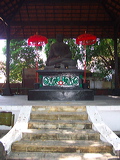 A stone image of the Buddha Akshobya, curiously matching the description of the 'missing statue' at Candi Jawi, can be found today in a small, secluded park in Surabaya. Known locally as Joko Dolog, the statue displays a lengthy sanskrit inscription, carved neatly around its base. When it was translated for the first time early in this century, the inscription was found to reveal important historical information dating from the period immediately prior to the founding of Majapahit. Executed in the year 1289 by a Buddhist scribe named Nada, the contents are roughly as follows: A stone image of the Buddha Akshobya, curiously matching the description of the 'missing statue' at Candi Jawi, can be found today in a small, secluded park in Surabaya. Known locally as Joko Dolog, the statue displays a lengthy sanskrit inscription, carved neatly around its base. When it was translated for the first time early in this century, the inscription was found to reveal important historical information dating from the period immediately prior to the founding of Majapahit. Executed in the year 1289 by a Buddhist scribe named Nada, the contents are roughly as follows:
It is said that in times long past the sage Mpu Bharada divided the land of Java into the kingdoms of Janggala and Panjalu (Kediri), with the purpose of settling a dispute between two brothers over the right to royal succession. The division was created magically, by means of holy water sprinkled out of a jar from the sky. Since the reign of Sri Wishnuwardhana, however, the country had been re-united, to the joy and benefit of all. The present ruler, of whom the statue was said to have been a portrait, was Wishnuwardhana's son, Kertanagara, who had commissioned the image as a symbol of this re-unification.
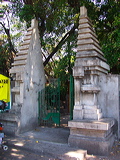 prasasti The information contained in the Joko Dolog inscription is prasasti The information contained in the Joko Dolog inscription is 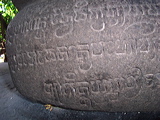 especially interesting because it appears to establish the authenticity of certain historical figures and events, previously known only from ancient Javanese literature. The story of the division of Java by the sage Mpu Bharada is of course well known, and refers to the reign of King Airlangga in the 11th century. On the other hand, by giving Wishnuwardhana the credit for having re-united the country, the inscription has tended to cast doubt upon the reliability of traditional literary sources, particularly with regard to the story of Ken Angrok and Ken Dedes, which has by some been dismissed as a complete fabrication. especially interesting because it appears to establish the authenticity of certain historical figures and events, previously known only from ancient Javanese literature. The story of the division of Java by the sage Mpu Bharada is of course well known, and refers to the reign of King Airlangga in the 11th century. On the other hand, by giving Wishnuwardhana the credit for having re-united the country, the inscription has tended to cast doubt upon the reliability of traditional literary sources, particularly with regard to the story of Ken Angrok and Ken Dedes, which has by some been dismissed as a complete fabrication.
Yet, since the discovery in 1975 of a number of inscribed copper sheets originating from the region of Kediri, new light has been shed on the early years of the Singosari period. Known as the inscription of Mula Malurung, issued by King Kertanagara in 1255, it mentions the names of Wishnuwardhana, Tohjaya, as well as a number of other kings whose names have been hitherto unknown to historians. Finally, and most interesting, the Mula Malurung inscription appears to suggest the existence of Ken Angrok, thus at least confirming an historical basis for a story which wa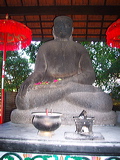 s be s be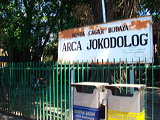 ginning ginning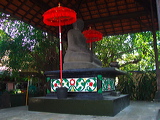 to fade entirely into the realm of myth. to fade entirely into the realm of myth.
  |
|
|
|
|
| Shiwa - Buddha
|
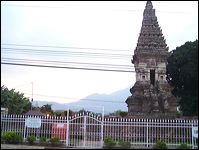 In the year A.D. 1359, on his return from an extended tour of the eastern provinces, King Hayam Wuruk of Majapahit stopped off at the temple of Jajawa (Candi Jawi) at Pandaan, in the foothills of Mt Welirang. His purpose was to place offerings at the shrine of his great-grandfather Kertanagara, last king of Singosari, in whose memory the temple had been built. The Nagarakertagama describes in detail the magnificence of the sacred compound. The principal monument, in particular, was unique in that it was a Shiwaite sanctuary crowned with a Buddhist ornament. It thus reflected clearly the advanced religious philosophy expounded by Kertanagara, who is said to have returned, on his death, to the realm of 'ShiwaBuddha'. The shrine further contained two mortuary statues of the king, representing the essence of both religions. Yet, as Prapanca explains in his poem, the image of the Buddha Akshobya had mysteriously disappeared at a time when the monument had been struck by lightning, in 1331. While regretting that the statue had vanished, it was accepted as a sign of the Buddha's supreme manifestation, i.e. that of Non-Being! In the year A.D. 1359, on his return from an extended tour of the eastern provinces, King Hayam Wuruk of Majapahit stopped off at the temple of Jajawa (Candi Jawi) at Pandaan, in the foothills of Mt Welirang. His purpose was to place offerings at the shrine of his great-grandfather Kertanagara, last king of Singosari, in whose memory the temple had been built. The Nagarakertagama describes in detail the magnificence of the sacred compound. The principal monument, in particular, was unique in that it was a Shiwaite sanctuary crowned with a Buddhist ornament. It thus reflected clearly the advanced religious philosophy expounded by Kertanagara, who is said to have returned, on his death, to the realm of 'ShiwaBuddha'. The shrine further contained two mortuary statues of the king, representing the essence of both religions. Yet, as Prapanca explains in his poem, the image of the Buddha Akshobya had mysteriously disappeared at a time when the monument had been struck by lightning, in 1331. While regretting that the statue had vanished, it was accepted as a sign of the Buddha's supreme manifestation, i.e. that of Non-Being!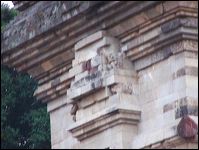
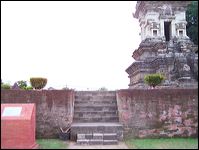 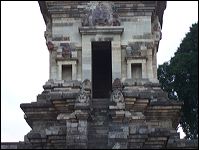
  |
|
|
|
|
|





